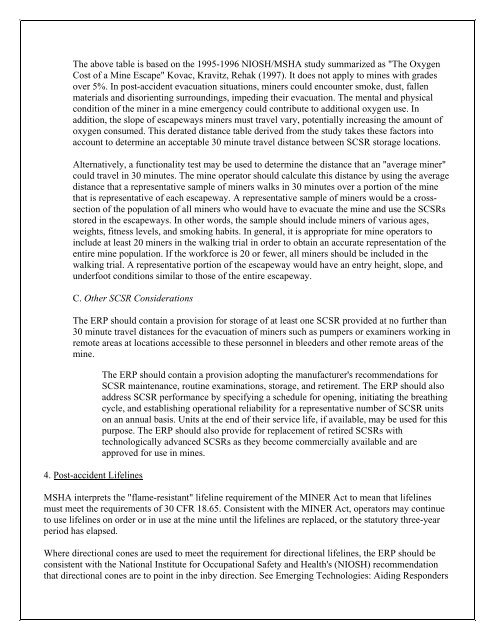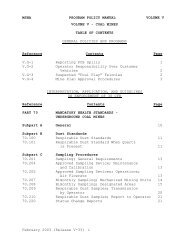Independent Review of MSHA's Actions at Crandall Canyon Mine
Independent Review of MSHA's Actions at Crandall Canyon Mine
Independent Review of MSHA's Actions at Crandall Canyon Mine
You also want an ePaper? Increase the reach of your titles
YUMPU automatically turns print PDFs into web optimized ePapers that Google loves.
The above table is based on the 1995-1996 NIOSH/MSHA study summarized as "The Oxygen<br />
Cost <strong>of</strong> a <strong>Mine</strong> Escape" Kovac, Kravitz, Rehak (1997). It does not apply to mines with grades<br />
over 5%. In post-accident evacu<strong>at</strong>ion situ<strong>at</strong>ions, miners could encounter smoke, dust, fallen<br />
m<strong>at</strong>erials and disorienting surroundings, impeding their evacu<strong>at</strong>ion. The mental and physical<br />
condition <strong>of</strong> the miner in a mine emergency could contribute to additional oxygen use. In<br />
addition, the slope <strong>of</strong> escapeways miners must travel vary, potentially increasing the amount <strong>of</strong><br />
oxygen consumed. This der<strong>at</strong>ed distance table derived from the study takes these factors into<br />
account to determine an acceptable 30 minute travel distance between SCSR storage loc<strong>at</strong>ions.<br />
Altern<strong>at</strong>ively, a functionality test may be used to determine the distance th<strong>at</strong> an "average miner"<br />
could travel in 30 minutes. The mine oper<strong>at</strong>or should calcul<strong>at</strong>e this distance by using the average<br />
distance th<strong>at</strong> a represent<strong>at</strong>ive sample <strong>of</strong> miners walks in 30 minutes over a portion <strong>of</strong> the mine<br />
th<strong>at</strong> is represent<strong>at</strong>ive <strong>of</strong> each escapeway. A represent<strong>at</strong>ive sample <strong>of</strong> miners would be a crosssection<br />
<strong>of</strong> the popul<strong>at</strong>ion <strong>of</strong> all miners who would have to evacu<strong>at</strong>e the mine and use the SCSRs<br />
stored in the escapeways. In other words, the sample should include miners <strong>of</strong> various ages,<br />
weights, fitness levels, and smoking habits. In general, it is appropri<strong>at</strong>e for mine oper<strong>at</strong>ors to<br />
include <strong>at</strong> least 20 miners in the walking trial in order to obtain an accur<strong>at</strong>e represent<strong>at</strong>ion <strong>of</strong> the<br />
entire mine popul<strong>at</strong>ion. If the workforce is 20 or fewer, all miners should be included in the<br />
walking trial. A represent<strong>at</strong>ive portion <strong>of</strong> the escapeway would have an entry height, slope, and<br />
underfoot conditions similar to those <strong>of</strong> the entire escapeway.<br />
C. Other SCSR Consider<strong>at</strong>ions<br />
The ERP should contain a provision for storage <strong>of</strong> <strong>at</strong> least one SCSR provided <strong>at</strong> no further than<br />
30 minute travel distances for the evacu<strong>at</strong>ion <strong>of</strong> miners such as pumpers or examiners working in<br />
remote areas <strong>at</strong> loc<strong>at</strong>ions accessible to these personnel in bleeders and other remote areas <strong>of</strong> the<br />
mine.<br />
4. Post-accident Lifelines<br />
The ERP should contain a provision adopting the manufacturer's recommend<strong>at</strong>ions for<br />
SCSR maintenance, routine examin<strong>at</strong>ions, storage, and retirement. The ERP should also<br />
address SCSR performance by specifying a schedule for opening, initi<strong>at</strong>ing the bre<strong>at</strong>hing<br />
cycle, and establishing oper<strong>at</strong>ional reliability for a represent<strong>at</strong>ive number <strong>of</strong> SCSR units<br />
on an annual basis. Units <strong>at</strong> the end <strong>of</strong> their service life, if available, may be used for this<br />
purpose. The ERP should also provide for replacement <strong>of</strong> retired SCSRs with<br />
technologically advanced SCSRs as they become commercially available and are<br />
approved for use in mines.<br />
MSHA interprets the "flame-resistant" lifeline requirement <strong>of</strong> the MINER Act to mean th<strong>at</strong> lifelines<br />
must meet the requirements <strong>of</strong> 30 CFR 18.65. Consistent with the MINER Act, oper<strong>at</strong>ors may continue<br />
to use lifelines on order or in use <strong>at</strong> the mine until the lifelines are replaced, or the st<strong>at</strong>utory three-year<br />
period has elapsed.<br />
Where directional cones are used to meet the requirement for directional lifelines, the ERP should be<br />
consistent with the N<strong>at</strong>ional Institute for Occup<strong>at</strong>ional Safety and Health's (NIOSH) recommend<strong>at</strong>ion<br />
th<strong>at</strong> directional cones are to point in the inby direction. See Emerging Technologies: Aiding Responders

















